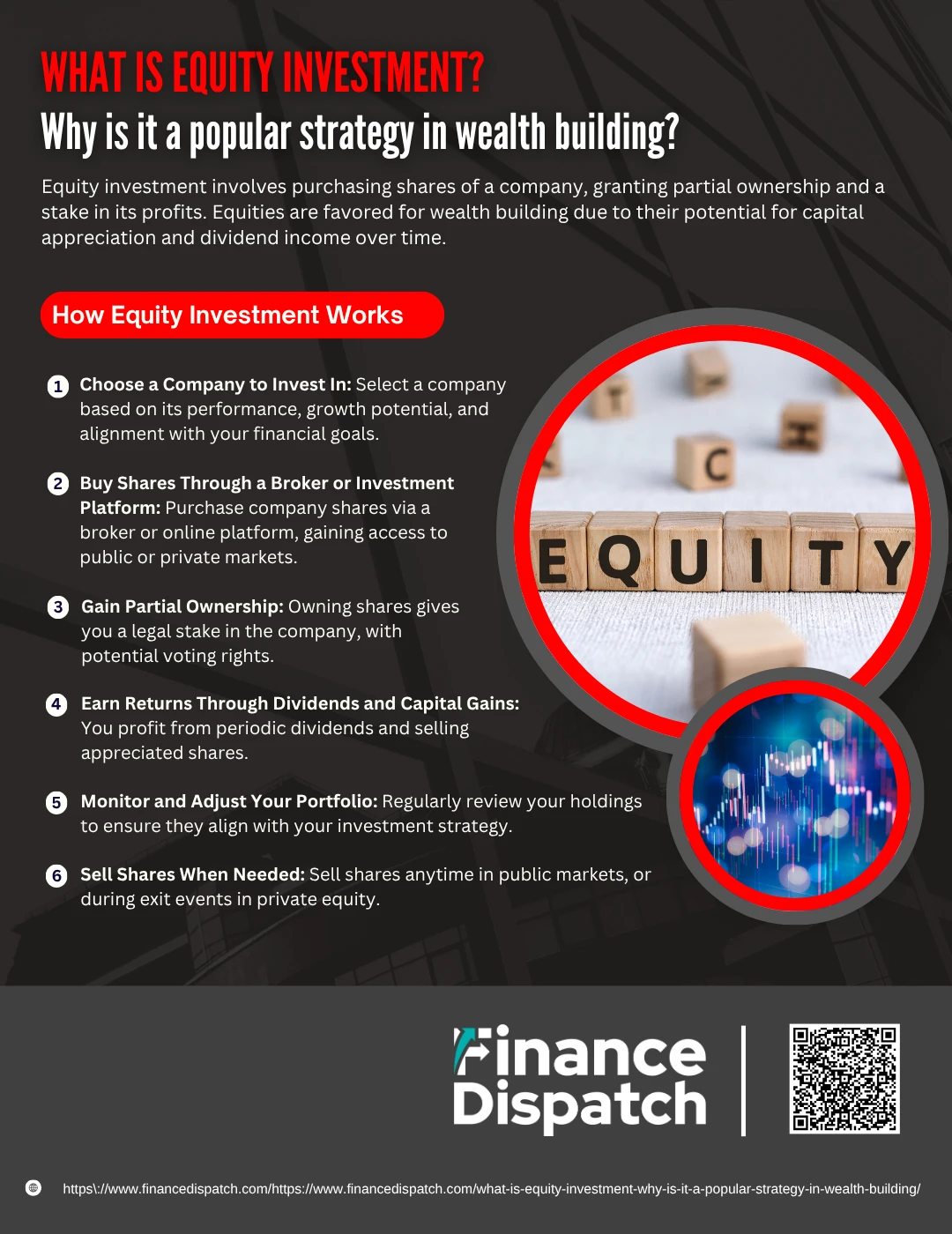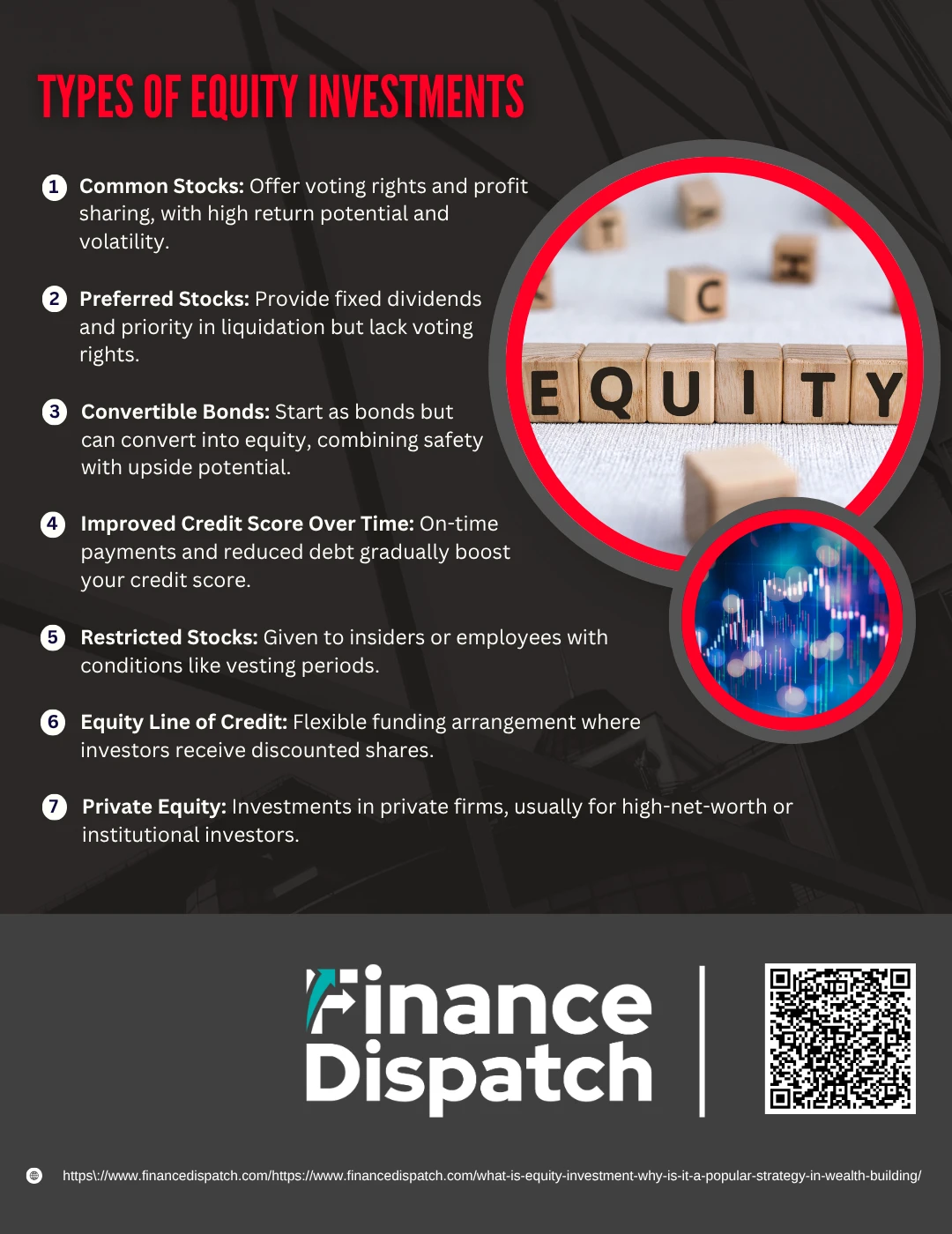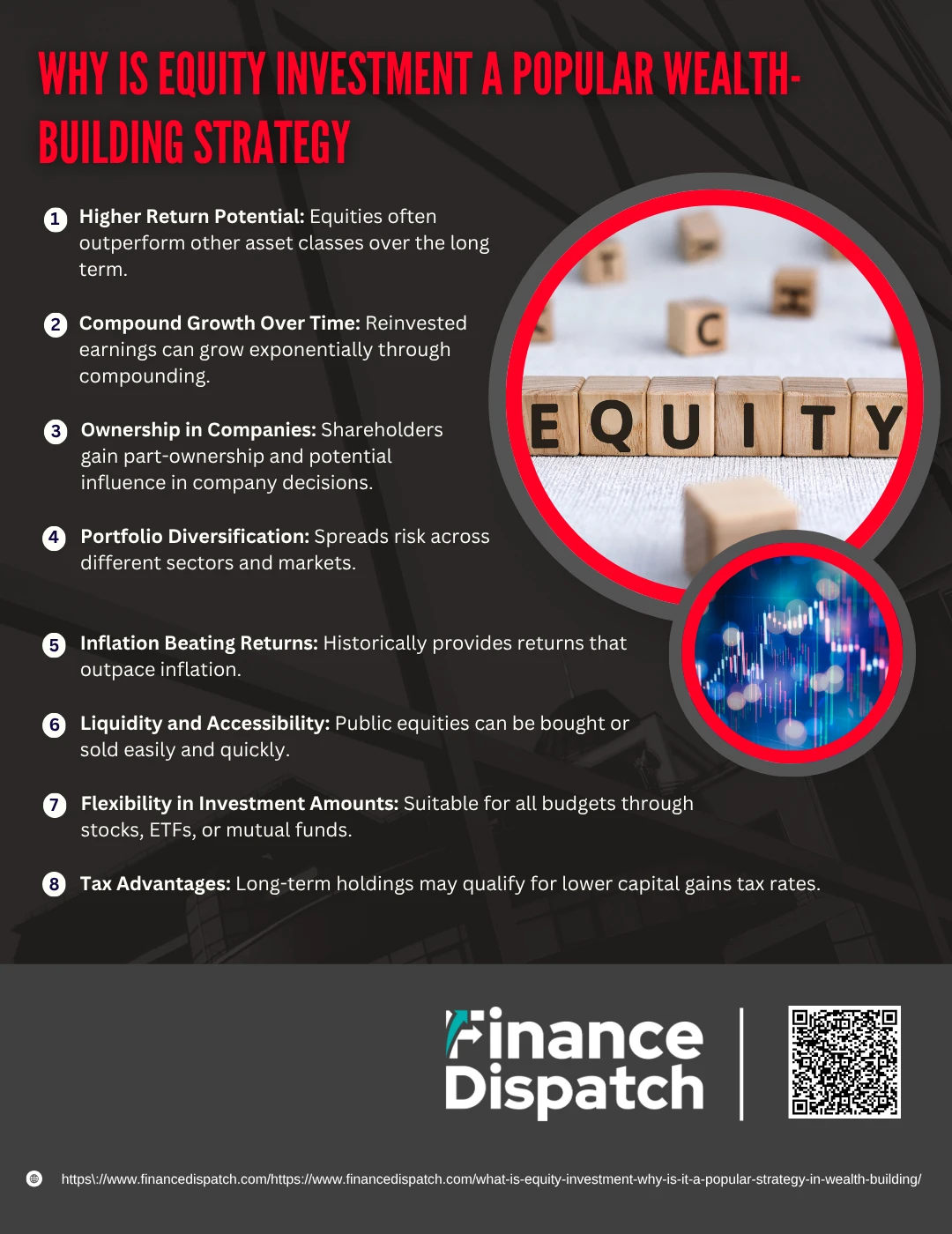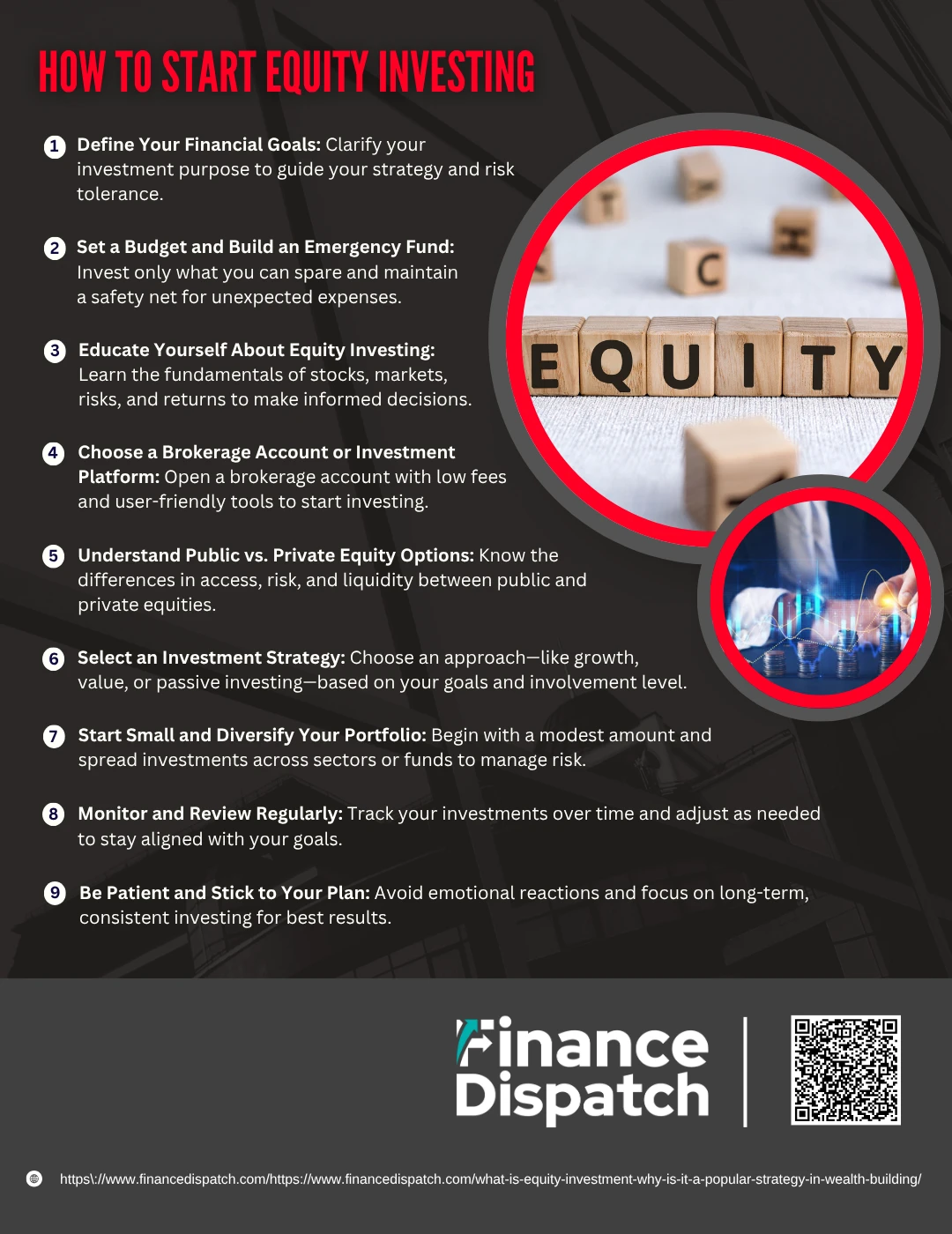Equity investment is one of the most recognized and effective strategies for building long-term wealth. Whether you’re a first-time investor or someone looking to diversify your portfolio, understanding how equity investing works is essential. At its core, equity investment involves purchasing shares of a company—making you a partial owner entitled to a portion of its profits and growth. Unlike traditional savings methods, equity investing offers the potential for higher returns through capital gains and dividends. However, it also requires a level of risk tolerance and strategic thinking. In this article, we’ll explore what equity investment is, how it functions, and why it continues to be a favored approach among investors aiming to grow their financial future.
What Is Equity Investment?
Equity investment refers to the process of buying shares in a public or private company, which gives the investor partial ownership of that business. When you invest in equity, you are purchasing a stake in the company, meaning you share in its profits—and its losses. These shares, commonly known as stocks, are traded on stock exchanges in the case of public companies. As a shareholder, you can earn money in two primary ways: through dividends, which are periodic payouts of the company’s earnings, and through capital gains, which occur when you sell your shares at a higher price than you paid. Equity investing is not only a means to participate in the success of a company but also a powerful tool for individuals seeking to build wealth over time.
 How Equity Investment Works
How Equity Investment Works
Equity investment allows individuals and institutions to participate in the ownership and potential success of a business by purchasing its shares. When you buy equity—commonly in the form of stocks—you’re not just lending money to a company as you would with bonds; you’re actually acquiring a piece of that company. This means you may benefit when the company performs well, either through dividend payments or an increase in the stock’s market value. At the same time, you also share in the risks if the company’s performance falters. Equity investing is a fundamental strategy for long-term wealth creation, and understanding how it works can help you make informed and strategic investment decisions. Here’s how the process typically unfolds:
1. Choose a Company to Invest In
The first step is selecting a company whose stock aligns with your financial goals. This involves researching the company’s business model, earnings reports, market position, and growth prospects. Many investors look for companies with consistent performance or potential for expansion.
2. Buy Shares Through a Broker or Investment Platform
Once you’ve decided where to invest, you can buy shares through a stockbroker or an online trading platform. For public companies, this involves placing an order on a stock exchange. In the case of private equity, access is usually limited to accredited investors or specialized investment firms.
3. Gain Partial Ownership
Buying shares makes you a shareholder, which means you legally own a portion of the company. The more shares you buy, the larger your ownership stake becomes. While common shareholders often have voting rights, ownership generally does not involve daily decision-making unless you hold a significant share.
4. Earn Returns Through Dividends and Capital Gains
Your investment can generate income in two ways. First, some companies distribute a portion of their profits as dividends. Second, if the company grows and becomes more valuable, its stock price usually rises—allowing you to sell your shares at a profit, known as capital gains.
5. Monitor and Adjust Your Portfolio
After investing, it’s important to track how your stocks are performing and whether they still align with your financial objectives. Investors often review company performance, market trends, and economic indicators to decide if adjustments are needed.
6. Sell Shares When Needed
You can sell your shares at any time through the stock market, depending on the liquidity of the asset. If the stock’s value has increased, selling allows you to realize profits. Conversely, if the company underperforms, you may decide to cut losses by selling early. In private equity, selling is less flexible and may involve finding buyers directly or waiting for an exit event like a company sale or IPO.
 Types of Equity Investments
Types of Equity Investments
Equity investments come in various forms, each offering unique opportunities and risks depending on the investor’s goals, risk tolerance, and the nature of the company involved. While the most well-known form is common stock traded on public exchanges, equity investments can also include other instruments such as preferred shares, convertible securities, and private equity. Understanding the different types helps investors build diversified portfolios and tailor strategies that align with their financial objectives. Below are the major types of equity investments:
1. Common Stocks
These are the most popular type of equity investment. When you buy common stock, you gain voting rights and a share in the company’s profits through dividends (if paid). Common stocks offer high return potential but are also subject to market volatility.
2. Preferred Stocks
Preferred shares offer more stable income through fixed dividends and have a higher claim on assets in case the company is liquidated. However, they usually don’t provide voting rights and may have limited price appreciation.
3. Convertible Bonds
These are hybrid instruments that start as bonds but can be converted into a predetermined number of shares. They offer the safety of fixed interest with the potential upside of equity if the company performs well.
4. Warrants
A warrant gives the holder the right to buy a company’s stock at a specific price before a certain date. Unlike regular shares, warrants are often issued directly by the company and are typically used in private equity or venture capital deals.
5. Restricted Stocks
Often awarded to employees or insiders, restricted stocks come with conditions like holding periods or performance milestones before they can be sold or transferred.
6. Equity Line of Credit
This involves an investor committing funds that a company can draw upon as needed, receiving equity (usually discounted shares) in return. It’s often used by startups or smaller companies seeking flexible funding.
7. Private Equity
Unlike public shares, private equity involves investing in private companies. These opportunities are usually limited to institutional investors or high-net-worth individuals and often come with higher risks and longer investment horizons.
 Why is Equity Investment a Popular Wealth-Building Strategy?
Why is Equity Investment a Popular Wealth-Building Strategy?
Equity investment continues to be one of the most preferred methods for growing wealth, especially for long-term investors. By purchasing shares in a company, investors gain a stake in its potential success—benefiting from both capital appreciation and dividend payouts. Unlike fixed-income options or savings accounts that offer limited returns, equities offer the chance to significantly grow your money over time. While they do carry higher risk, they also provide unmatched opportunities for financial growth when approached with discipline, research, and a long-term perspective. Below are the key reasons why equity investment is widely embraced as a wealth-building strategy:
1. Higher Return Potential
Equities have consistently delivered higher returns compared to other investment types such as bonds or savings accounts. Over the long term, companies that grow in value can multiply an investor’s original capital many times over.
2. Compound Growth Over Time
One of the strongest advantages of equity investing is compounding. Reinvesting dividends and capital gains allows earnings to generate further earnings, creating exponential growth if investments are held over the years.
3. Ownership in Companies
Investing in equities means becoming a shareholder—an actual owner of part of the company. This ownership entitles you to a share of profits and assets and often includes voting rights, giving you a voice in certain corporate decisions.
4. Portfolio Diversification
Equities can help spread risk across different sectors, industries, and geographic regions. This diversification can protect your wealth from the poor performance of any one company or market segment.
5. Inflation Beating Returns
Inflation reduces the value of money over time, but equities have historically provided returns that exceed inflation. This ensures that your investment not only retains but increases its purchasing power.
6. Liquidity and Accessibility
Unlike real estate or fixed deposits, equity investments—especially in public markets—can be bought or sold at any time. This liquidity provides flexibility for investors to respond to market changes or personal financial needs.
7. Flexibility in Investment Amounts
Equity investing is highly scalable. Whether you’re starting with $100 or $100,000, you can invest through individual stocks, mutual funds, or ETFs, making it accessible to both new and experienced investors.
8. Tax Advantages
In many tax systems, long-term capital gains and qualified dividends are taxed at lower rates than ordinary income. This tax efficiency enhances the real returns of equity investments, especially when held over extended periods.
Key Strategies in Equity Investing
Equity investing isn’t just about buying and holding stocks—it involves selecting specific strategies that align with your financial goals, risk tolerance, and investment timeline. Choosing the right strategy can improve your chances of earning consistent returns and managing risk effectively. Whether you’re investing in public markets or exploring private equity opportunities, understanding various equity strategies can help you build a more resilient and profitable portfolio. Below are some of the most widely used strategies in equity investing:
1. Value Investing
This approach focuses on finding undervalued stocks that are trading below their intrinsic value. Investors using this strategy seek long-term gains by buying low and holding until the stock price reflects its true worth.
2. Growth Investing
Growth investors target companies with high potential for expansion and earnings growth, even if the current stock price seems expensive. These companies often reinvest profits to fuel growth rather than pay dividends.
3. Active Investing
Active investors frequently trade stocks to capitalize on short-term price fluctuations. This strategy relies heavily on market timing, technical analysis, and staying informed about news that can affect stock performance.
4. Index and Fund Investing
This passive strategy involves investing in index funds or ETFs that mirror the performance of major stock market indices. It offers broad diversification, lower fees, and is ideal for long-term, hands-off investors.
5. Venture Capital and Private Equity
This high-risk, high-reward strategy involves investing in early-stage or private companies. Often used by institutional investors, it requires substantial capital and patience as returns may take years to realize.
6. Dividend Investing
Investors following this strategy focus on companies that pay regular dividends. It provides a steady income stream and is often favored by retirees or conservative investors seeking lower-risk returns.
7. Thematic or Sector Investing
This involves targeting specific industries or trends—such as technology, green energy, or healthcare—based on their long-term potential. The strategy banks on picking sectors poised for above-average growth.
8. Dollar-Cost Averaging
Instead of investing a lump sum, this strategy involves investing a fixed amount at regular intervals, regardless of market conditions. It helps smooth out market volatility and reduces timing risks.
 How to Start Equity Investing
How to Start Equity Investing
Starting your journey in equity investing can feel overwhelming, but it’s one of the most effective ways to build long-term wealth. Unlike traditional savings methods, equity investing allows you to participate in the growth of companies and the broader economy. It’s not just about picking the “right” stocks—it’s about having a plan, understanding the risks, and staying committed to your financial goals. Whether you’re a beginner or transitioning from other types of investments, the process becomes much easier when broken down into clear, manageable steps. Here’s a more detailed guide to help you get started:
1. Define Your Financial Goals
Begin by understanding what you’re investing for. Are you saving for retirement, a child’s education, a future home, or simply growing wealth? Your investment goals will influence your risk tolerance, time horizon, and the types of equity investments you choose.
2. Set a Budget and Build an Emergency Fund
Decide how much you can realistically invest without impacting your day-to-day financial needs. It’s essential to keep a separate emergency fund—typically covering 3 to 6 months of expenses—so that you’re not forced to sell your investments in a downturn.
3. Educate Yourself About Equity Investing
Learn the basics: what are stocks, how does the stock market work, what are dividends and capital gains, and how risk and return are related. Resources like financial blogs, beginner investing courses, and tutorials can be extremely helpful in building foundational knowledge.
4. Choose a Brokerage Account or Investment Platform
To buy stocks, you’ll need to open a brokerage account. Look for platforms with low fees, intuitive interfaces, and tools like research reports, performance trackers, and educational materials. Some platforms also offer robo-advisors for automated investing based on your risk profile.
5. Understand Public vs. Private Equity Options
Most new investors start with public equity (stocks traded on exchanges) because it’s accessible and liquid. Private equity, on the other hand, involves investing in privately held companies and usually requires more capital and a longer holding period.
6. Select an Investment Strategy
Consider whether you want to focus on growth stocks, value stocks, dividend-paying companies, or passive index funds. Your strategy should align with your risk appetite and how involved you want to be in managing your investments.
7. Start Small and Diversify Your Portfolio
You don’t need a lot of money to begin. Start with a small amount and invest across different sectors or companies. Mutual funds or ETFs can offer built-in diversification, which helps reduce the risk of any single investment dragging down your overall returns.
8. Monitor and Review Regularly
Check in on your investments periodically, but avoid obsessing over daily market fluctuations. Instead, focus on whether your portfolio aligns with your long-term goals. Rebalance if necessary by adjusting the proportion of certain holdings.
9. Be Patient and Stick to Your Plan
Equity investing rewards discipline and long-term thinking. Market dips are normal, but reacting emotionally can undermine your progress. Consistently contribute to your investments and give them time to grow.
Risks of Equity Investment and How to Manage Them
While equity investing offers substantial potential for long-term wealth creation, it is not without risks. Stock markets can be unpredictable, and the value of your investments may fluctuate due to various internal and external factors. Understanding these risks is essential for making informed decisions and protecting your capital. Fortunately, there are proven strategies to help manage and minimize these risks. Below are the key risks associated with equity investments and how you can effectively manage them:
1. Market Risk
The value of stocks can rise or fall due to overall market movements caused by economic changes, interest rate shifts, or global events.
Management Tip: Diversify across sectors and asset classes to cushion against broad market volatility.
2. Company-Specific Risk
Poor management decisions, declining sales, or legal troubles can negatively impact a specific company’s stock price.
Management Tip: Conduct thorough research before investing and avoid putting too much money into a single company.
3. Liquidity Risk
Some stocks, especially in smaller or private companies, may not be easy to sell quickly without affecting the price.
Management Tip: Focus on investing in well-traded, liquid stocks and maintain an emergency fund outside your equity portfolio.
4. Foreign Exchange and Political Risk
For international investments, currency fluctuations or political instability in foreign countries can affect returns.
Management Tip: Limit exposure to unstable regions and consider hedging currency risk where necessary.
5. Economic Concentration Risk
Investing too heavily in a single industry or economic sector can lead to significant losses if that sector underperforms.
Management Tip: Spread investments across various industries and geographic regions.
6. Inflation Risk
If your equity returns don’t outpace inflation, your purchasing power may decline over time.
Management Tip: Focus on growth-oriented investments and reinvest dividends to help maintain real returns.
7. Emotional and Behavioral Risk
Investors often panic during market downturns and make impulsive decisions that hurt long-term gains.
Management Tip: Stick to a long-term investment plan and avoid reacting emotionally to short-term market movements.
Long-Term Wealth Creation through Equities
Equity investing is widely regarded as one of the most effective tools for building wealth over the long term. Unlike short-term trading or speculative investments, long-term equity investing focuses on the gradual growth of capital through consistent investing, reinvestment of dividends, and the power of compounding. Historical trends have shown that, despite periodic market volatility, equities tend to outperform other asset classes over extended periods. When approached with patience, discipline, and strategy, equity investments can help individuals achieve major financial goals such as retirement, home ownership, or education funding. Here are the key reasons equities are ideal for long-term wealth creation:
1. Power of Compounding
Reinvesting dividends and capital gains allows your money to generate earnings on past earnings, significantly accelerating wealth over time.
2. Higher Average Returns
Historically, equities have delivered higher returns than bonds, savings accounts, or fixed deposits, making them ideal for long-term growth.
3. Inflation Protection
Stocks have the potential to outpace inflation, helping your investments retain and even increase their purchasing power over decades.
4. Benefit from Business Growth
As companies grow and increase in value, shareholders benefit through rising stock prices and increased dividend payouts.
5. Time Smooths Volatility
While short-term stock prices fluctuate, long-term investments tend to average out market dips and deliver more stable returns.
6. Tax Efficiency
Many jurisdictions offer lower tax rates on long-term capital gains, increasing your net returns compared to short-term profits.
7. Discipline Encourages Better Habits
Long-term investing encourages consistent savings, reduces emotional decision-making, and builds strong financial discipline.
8. Dividend Reinvestment Opportunities
Dividends, when reinvested, can purchase more shares, further increasing your investment base and compounding effect.
9. Accessible Through Funds and ETFs
Even if you don’t pick individual stocks, index funds and equity mutual funds allow for diversified, long-term participation in the equity market.
Conclusion
Equity investment remains one of the most powerful strategies for long-term wealth creation. By owning shares in companies, investors gain the potential to grow their money through capital appreciation, dividends, and the power of compounding. While equities come with risks, these can be managed effectively through diversification, research, and disciplined investing. With the flexibility to start small, adapt strategies, and stay invested through market cycles, equity investing empowers individuals to build a financially secure future. Whether you’re aiming for retirement, funding education, or achieving financial independence, a well-planned equity investment approach can be your strongest ally on the path to lasting wealth.



